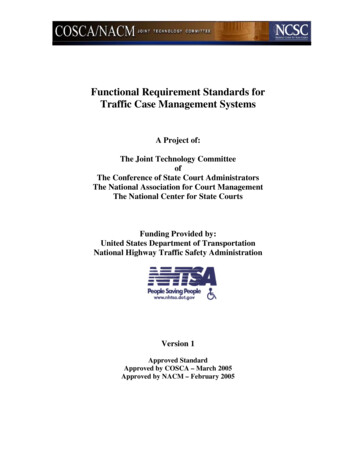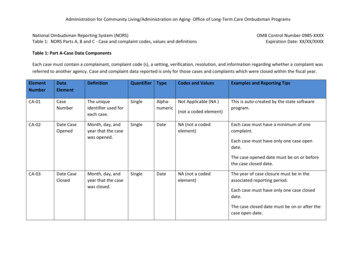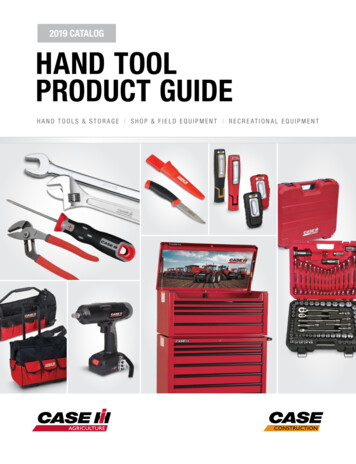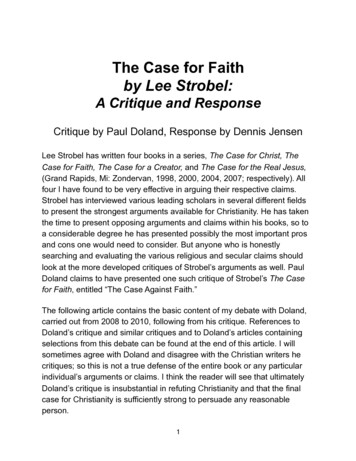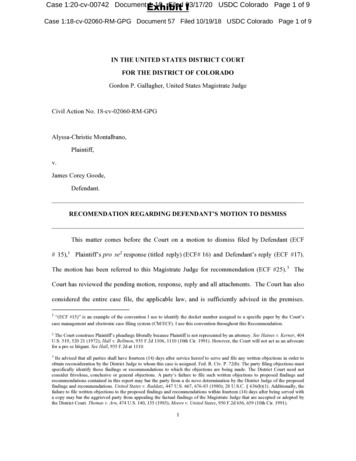
Transcription
Case 1:20-cv-00742 DocumentExhibit1-10 Filed 03/17/20USDC Colorado Page 1 of 9ICase 1:18-cv-02060-RM-GPG Document 57 Filed 10/19/18 USDC Colorado Page 1 of 9IN THE UNITED STATES DISTRICT COURTFOR THE DISTRICT OF COLORADOGordon P. Gallagher, United States Magistrate JudgeCivil Action No. 18-cv-02060-RM-GPGAlyssa-Christie Montalbano,Plaintiff,v.James Corey Goode,Defendant.RECOMENDATION REGARDING DEFENDANT’S MOTION TO DISMISSThis matter comes before the Court on a motion to dismiss filed by Defendant (ECF# 15),1 Plaintiff’s pro se2 response (titled reply) (ECF# 16) and Defendant’s reply (ECF #17).The motion has been referred to this Magistrate Judge for recommendation (ECF #25). 3 TheCourt has reviewed the pending motion, response, reply and all attachments. The Court has alsoconsidered the entire case file, the applicable law, and is sufficiently advised in the premises.1“(ECF #15)” is an example of the convention I use to identify the docket number assigned to a specific paper by the Court’scase management and electronic case filing system (CM/ECF). I use this convention throughout this Recommendation.2The Court construes Plaintiff’s pleadings liberally because Plaintiff is not represented by an attorney. See Haines v. Kerner, 404U.S. 519, 520 21 (1972); Hall v. Bellmon, 935 F.2d 1106, 1110 (10th Cir. 1991). However, the Court will not act as an advocatefor a pro se litigant. See Hall, 935 F.2d at 1110.3Be advised that all parties shall have fourteen (14) days after service hereof to serve and file any written objections in order toobtain reconsideration by the District Judge to whom this case is assigned. Fed. R. Civ. P. 72(b). The party filing objections mustspecifically identify those findings or recommendations to which the objections are being made. The District Court need notconsider frivolous, conclusive or general objections. A party’s failure to file such written objections to proposed findings andrecommendations contained in this report may bar the party from a de novo determination by the District Judge of the proposedfindings and recommendations. United States v. Raddatz, 447 U.S. 667, 676-83 (1980); 28 U.S.C. § 636(b)(1). Additionally, thefailure to file written objections to the proposed findings and recommendations within fourteen (14) days after being served witha copy may bar the aggrieved party from appealing the factual findings of the Magistrate Judge that are accepted or adopted bythe District Court. Thomas v. Arn, 474 U.S. 140, 155 (1985); Moore v. United States, 950 F.2d 656, 659 (10th Cir. 1991).1
Case 1:20-cv-00742 Document 1-10 Filed 03/17/20 USDC Colorado Page 2 of 9Case 1:18-cv-02060-RM-GPG Document 57 Filed 10/19/18 USDC Colorado Page 2 of 9Oral argument has not been requested and the Court finds that it is not necessary in thiscircumstance. This Magistrate Judge respectfully recommends that the motion be GRANTED.This matter, which was removed from state court, was instigated by the filing ofPlaintiff’s “notice of default in dishonor” (ECF #26, pp. 6-7) and a letter to “Corey” dated June4, 2018 (ECF #26, pp. 3-5). Additionally, other documents have been filed in this action whichappear to be in the nature of a complaint. See amendment/supplement notice of removal (ECF#12). As noted above, this matter comes before the Court after being removed from the statecourt, to wit, Mesa County. The manner of removal was haphazard at best and it is not entirelyclear to the Court what the Plaintiff intended to construe as her initial complaint. As Plaintiffproceeds pro se, and as I must liberally construe the pleading consistent with Haines and Hall,see fn. 2, I am casting a wider net in terms of review of the initial pleadings.Plaintiff’s claimsAs discerned from the various documents set forth below, which may or may not actuallybe Plaintiff’s complaint, the Court construes that Plaintiff is attempting to proceed on thefollowing supposed causes of action: (1) unauthorized use of intellectual property; (2) theft ofcopyrighted materials; (3) defamation; (4) slander; (5) libel; (5) fraudulent stalking; and (6)fraud.2
Case 1:20-cv-00742 Document 1-10 Filed 03/17/20 USDC Colorado Page 3 of 9Case 1:18-cv-02060-RM-GPG Document 57 Filed 10/19/18 USDC Colorado Page 3 of 9Notice of Default in Dishonor (ECF #26, pp. 6-7)This document appears to the Court to be in the nature of a certificate of service.Therein, Plaintiff informs “Respondent,” James Corey Goode, of a number of documents he haspurportedly be presented with and that he has “one week . . .to accept my offer for remedyrevised.” Id. This document does not state a claim upon which relief can be granted, in no waycomplies with the pleading requirements of Rule 8, and bears no further discussion.Letter to Corey dated June 4, 2018 (ECF #26, pp. 3-6)This letter makes no claim for relief and bears no further discussion.Amendment/Supplement Notice of Removal (ECF #12)a.Motion to Order, cease and desist unauthorized use of intellectual property, dreamvisions, copyrighted materials and defamation of character (ECF #12-1):Plaintiff claims that Mr. Goode “has been using [Plaintiff’s] intellectual property, dreamvisions, and copyrighted materials to his benefit.” Id. at p. 2, para. (a).Plaintiff claims that Mr. Goode “agrees he and associates plan to continue to use[Plaintiff’s] materials to their benefit and [Plaintiff’s] detriment.” Id. at p. 2, para. (b).Plaintiff claims that Mr. Goode has been libeling, slandering, defaming, and fraudulentlystalking Plaintiff. Id. at p. 2, para. (c).3
Case 1:20-cv-00742 Document 1-10 Filed 03/17/20 USDC Colorado Page 4 of 9Case 1:18-cv-02060-RM-GPG Document 57 Filed 10/19/18 USDC Colorado Page 4 of 9Plaintiff claims that Mr. Goode has been “performing military grade tactics” to defraudPlaintiff’s “intellectual property, dream visions, and copyrighted materials during 2017 and into2018” and that there is 70,000.00 in damages. Id. at p. 2, para. (d).b.Memorandum brief in support of motion to order (ECF #12-1, pp. 18-24):Plaintiff claims that she emailed materials to Mr. Goode for use in the show “CosmicDisclosure” on “GAIA INC” and that Plaintiff was defrauded in that Mr. Goode used Plaintiff’smaterials for “profiteering and public acclaim.” (ECF #12-1, pp. 18-24, para. 21, passim).Plaintiff provides specific examples of the intellectual property she believes wasmisappropriated at pages 41-48 (ECF #12-1). These include what Plaintiff terms as “intellectualproperty” (ECF #12-1, p 41) and which Plaintiff states she herself emailed to Defendant atvarious times.Standard of ReviewThe Court may dismiss a complaint for failure to state a claim upon which relief can begranted. Fed.R.Civ.P. 12(b)(6). Dismissal under Rule 12(b)(6) may also be based on the lack of acognizable legal theory. See Golan v. Ashcroft, 310 F. Supp. 2d 1215, 1217 (D. Colo. 2004).To withstand a Rule 12(b)(6) motion to dismiss, a complaint must contain enough allegations offact, which, taken as true, “state a claim to relief that is plausible on its face.” Bell Atlantic Corp.v. Twombly, 550 U.S. 544, 570 (2007); Khalik v. United Air Lines, 671 F.3d 1188, 1190 (10thCir. 2012). Although allegations of fact are accepted as true, legal conclusions are not. Ashcroft4
Case 1:20-cv-00742 Document 1-10 Filed 03/17/20 USDC Colorado Page 5 of 9Case 1:18-cv-02060-RM-GPG Document 57 Filed 10/19/18 USDC Colorado Page 5 of 9v. Iqbal, 556 U.S. 662, 678–79 (2009). Mere “labels and conclusions” and “a formulaic recitationof the elements of a cause of action” will not suffice. Twombly, 550 U.S. at 555. “Factualallegations must be enough to raise a right to relief above the speculative level.”Id.Accordingly, the Court disregards conclusory statements and looks only to whether theremaining factual allegations plausibly suggest the defendant is liable. Khalik, 671 F.3d at 119091.Where the allegations in a complaint “are so general that they encompass a wide swath ofconduct, much of it innocent, then the plaintiffs have not nudged their claims across the line fromconceivable to plausible.” Robbins v. Oklahoma, 519 F.3d 1242, 1247 (10th Cir. 2008) (internalquotations omitted) (“The nature and specificity of the allegations required to state a plausibleclaim will vary based on context . . . [and] requires the reviewing court to draw on its judicialexperience and common sense.” Kansas Penn Gaming, LLC v. Collins, 656 F.3d 1210, 1214-15(10th Cir. 2011)).“The mere metaphysical possibility that some plaintiff could prove some set offacts in support of the pleaded claims is insufficient; the complaint must give thecourt reason to believe this plaintiff has a reasonable likelihood of musteringfactual support for these claims.”Ridge at Red Hawk, L.L.C. v. Schneider, 493 F.3d 1174, 1177 (10th Cir. 2007) (emphasis inoriginal).As was noted in Robbins, “context matters.”Robbins, 519 F.3d at 1248 (citationremoved). “A simple negligence action based on an automobile accident may require little morethan the allegation that the defendant negligently struck the plaintiff with his car while crossing a5
Case 1:20-cv-00742 Document 1-10 Filed 03/17/20 USDC Colorado Page 6 of 9Case 1:18-cv-02060-RM-GPG Document 57 Filed 10/19/18 USDC Colorado Page 6 of 9particular highway on a specified date and time.” Id. “[I]t is particularly important . . . that thecomplaint make clear exactly who is alleged to have done what to whom, to provide eachindividual with fair notice as to the basis of the claims against him or her, as distinguished fromcollective allegations . . .” Id. at 1250 (emphasis in original) (continuing on to determine thatcollective allegations against defendants as a whole makes it impossible to ascertain what anyspecific defendant may have done).Rule 8The twin purposes of a complaint are to give the opposing parties fair notice of the basisfor the claims against them so that they may respond and to allow the Court to conclude that theallegations, if proven, show that the plaintiff is entitled to relief. See Monument Builders ofGreater Kansas City, Inc. v. American Cemetery Ass’n of Kansas, 891 F.2d 1473, 1480 (10thCir. 1989).The requirements of Rule 8 are designed to meet these purposes.See TVCommunications Network, Inc. v. ESPN, Inc., 767 F. Supp. 1062, 1069 (D. Colo. 1991), aff’d,964 F.2d 1022 (10th Cir. 1992). Rule 8(a) provides that a complaint “must contain (1) a shortand plain statement of the grounds for the court’s jurisdiction, . . . (2) a short and plain statementof the claim showing that the pleader is entitled to relief; and (3) a demand for the relief sought.”The philosophy of Rule 8(a) is reinforced by Rule 8(d)(1), which provides that “[e]ach allegationmust be simple, concise, and direct.” “At some point the factual detail in a complaint may be sosketchy that the complaint does not provide the type of notice of the claim to which the defendantis entitled under Rule 8.” Airborne Beepers & Video, Inc. v. AT & T Mobility L.L.C., 499 F.3d663, 667 (7th Cir. 2007) (emphasis mine). The philosophy of Rule 8(a) is reinforced by Rule8(d)(1), which provides that "[e]ach allegation must be simple, concise, and direct." Taken6
Case 1:20-cv-00742 Document 1-10 Filed 03/17/20 USDC Colorado Page 7 of 9Case 1:18-cv-02060-RM-GPG Document 57 Filed 10/19/18 USDC Colorado Page 7 of 9together, Rules 8(a) and (d)(1) underscore the emphasis placed on clarity and brevity by thefederal pleading rules. Prolix, vague, or unintelligible pleadings violate Rule 8.Copyright InfringementPlaintiff claims, without providing any information as to the copyright at issue, that hercopyright was infringed. To prevail on a claim of copyright infringement, a Plaintiff must prove:(1) the work is the subject of a valid copyright; (2) the plaintiff owns the copyright; (3) thedefendant copied the protected expression in plaintiff’s copyrighted work. See Feist Publ’ns,Inc. v. Rural Tel. Serv. Co., 499 U.S. 340, 361 (1991).Plaintiff has in no way proven that any work is the subject of a valid copyright, anessential element to proving copyright infringement. In the absence of even minimal proof of acopyright, Plaintiff has no met the pleading standards to move forward on this claim.Plaintiff has not met the pleading standards required under Rule 8. Plaintiff’s variousattempt at a complaint, which defy the Court to even determine which pleading is intended as theoperative complaint, do not contain: (1) a short and plain statement of the grounds for the court’sjurisdiction, . . . (2) a short and plain statement of the claim showing that the pleader is entitled torelief; nor (3) a demand for the relief sought. Further, with regard to Rule 12, Plaintiff has failedto state a claim to relief that is plausible on its face. With all due respect to Plaintiff’s beliefs, aspresented to the Court, they do not support the causes of action to even the minimal standards setforth under Rules 8 and 12.7
Case 1:20-cv-00742 Document 1-10 Filed 03/17/20 USDC Colorado Page 8 of 9Case 1:18-cv-02060-RM-GPG Document 57 Filed 10/19/18 USDC Colorado Page 8 of 9Plaintiff asserts the violation of a legal interest that clearly does not exist or facts that donot support an arguable claim for relief. The complaint(s) lack coherent factual allegations orclaims. They describe what seems a delusional scenario of use of supposed dreams emailed toanother party. The nonsensical allegations do not support an arguable claim for relief, and a morespecific pleading would not cure the failure of the purported claims nor place them in a position toclear the hurdles of Rule 8 or 12. The complaint fails to provide a short and plain statement of Plaintiff’sclaims showing that she is entitled to relief. It is disjointed and confusing.The general rule that pro se pleadings must be construed liberally has limits, and “the courtcannot take on the responsibility of serving as the litigant’s attorney in constructing arguments andsearching the record.” Garrett v. Selby Connor Maddux & Janer, 425 F.3d 836, 840 (10th Cir. 2005); seealso United States v. Dunkel, 927 F.2d 955, 956 (7th Cir. 1991) (“Judges are not like pigs, hunting fortruffles buried in briefs.”); Ketchum v. Cruz, 775 F. Supp. 1399, 1403 (D. Colo. 1991) (vague andconclusory allegations that his rights have been violated does not entitle a pro se pleader to a day in courtregardless of how liberally the pleadings are construed), aff’d, 961 F.2d 916 (10th Cir. 1992). “[I]nanalyzing the sufficiency of the plaintiff’s complaint, the court need accept as true only the plaintiff’swell-pleaded factual contentions, not his conclusory allegations.” Hall, 935 F.2d at 1110. Here, despitethe Court’s prior advisement, Plaintiff has failed to plead a short and plain statement of his claimsshowing that she is entitled to relief.For the foregoing reasons, I respectfully RECOMMEND that the motion to dismiss beGRANTED.8
Case 1:20-cv-00742 Document 1-10 Filed 03/17/20 USDC Colorado Page 9 of 9Case 1:18-cv-02060-RM-GPG Document 57 Filed 10/19/18 USDC Colorado Page 9 of 9With regard to the pleadings filed by Defendant, through Counsel, the Court would notethat Counsel’s rhetorical flourishes, e.g., “Its Complaint fails for not many reasons, but for allreasons . . .real or imaginable, in state court or federal, in this dimension or the next” (ECF #15,p. 1) (sic) (emphasis original), are unnecessary and detract from a reasoned and cogent argument.Dated at Grand Junction, Colorado this October 19, 2018.Gordon P. GallagherUnited States Magistrate Judge9
Therein, Plaintiff informs "Respondent," James Corey Goode, of a number of documents he has purportedly be presented with and that he has "one week . . .to accept my offer for remedy . Letter to Corey dated June 4, 2018 (ECF #26, pp. 3-6) This letter makes no claim for relief and bears no further discussion.



